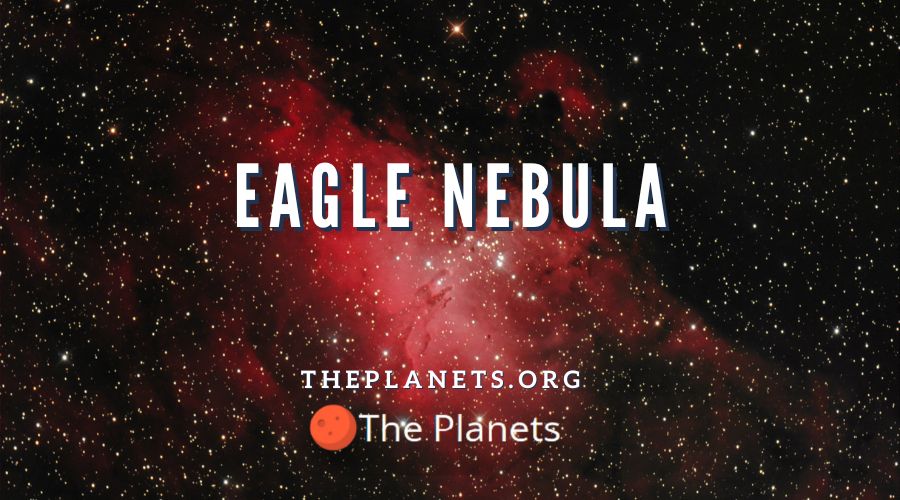
The Eagle Nebula currently has a brightness magnitude rating of six, which makes it relatively easy to spot on a clear night with a small telescope or even a strong set of binoculars. This makes it a popular target for budding and amateur astronomers learning to map the night sky.
Depending on the measurement points used, the Eagle Nebula’s most famous feature, the Pillars of Creation, ranges from four to five light years in diameter. But the entire Eagle Nebula formation is truly on a massive scale, measuring 70 by 50 light years in total. Located in the less well known constellation of Serpens, the Eagle Nebula is positioned at far true west.
Many visuals of the Eagle Nebula exist and these can make the formation look very different from one image to the next. The differences lie in the type of photography lenses and equipment used, the elements measured and also when the image was captured. For example, the Eagle Nebula will look very different in visible light than in infrared or in ultraviolet images.
Today it is estimated that the Eagle Nebula is 5.5 million years old.

Eagle Nebula Profile
Here is a quick overview of the Eagle Nebula’s basic statistics.
Designation: M (Messier) 16, NGC (New General Catalog) 6611, Pillars of Creation, Spire Nebula, Star Queen Nebula
Type: Diffuse emission region (H II Region, or IC 4703); young open star cluster.
Diameter: 70 light years by 50 light years
Distance: 7,000 light years
Mass: 12,000+ solar masses
Constellation: Serpens
Facts & Features
- The Eagle Nebula is a young open star cluster and also a diffuse emission region. Both of these aspects comprise the complete Eagle Nebula formation.
- The Eagle Nebula’s star cluster was first discovered by the Swiss astronomer Jean-Philippe de Chéseaux in 1745. It was formally categorized and presented by de Chéseaux in 1746 to a gathering called the Académie Française des Sciences. The list was kept private until 1892, when it was released for public access.
- The Eagle Nebula’s diffuse emission region was discovered by the French astronomer Charles Messier in 1764 and added to the astronomer’s growing (and soon to be extensive) star catalog.
- The Eagle Nebula is so vast and enormous that a single spire of gaseous matter in its north-eastern region is in itself 9.5 light years (90 trillion km) long! The entire formation is 70 light years by 50 light years. For comparison, one light year is the distance light can travel in one year’s time – NASA estimates this to be 5.9 trillion miles (9.5 trillion km).
- The young star cluster contained within the limits of the Eagle Nebula includes an estimated more than a thousand young stars in varying stages of growth. This cluster’s brightest star is one million times as bright as the Sun.
- The age of the star cluster itself is estimated to be 5.5 million years old. Within the star cluster are many different types of formations, including protostars (stars-to-be) and EGGs (evaporating gaseous globules) that are like incubators for protostars.
- The gaseous nebula surrounding the Eagle Nebula’s star cluster is comprised mostly of hydrogen gas and cosmic dust. Hydrogen gas is a primary building block fuel for young stars. The formation called the Pillars of Creation is also an intense area of cosmic dust and hydrogen gas and it, too, is involved with helping to create young stars.
- Because it takes the light emitted by the Eagle Nebula so long to reach Earth (on average 1,000 to 2,000 years after being emitted at its source), much could have changed inside the nebula itself from the most recent information received on Earth. For this, NASA’s deep space Hubble Space Telescope has provided fresh views that would not be available in any other ay.
- Images taken by NASA’s Chandra X-Ray Observatory indicate that the area called the Pillars of Creation is nearing the end of its star-forming days. This observation came about after the Chandra images revealed only a limited number of X-ray areas – X-rays are indicators that new stars are being made.
- The Pillars of Creation and the entire Eagle Nebula itself show changes every single time new images are taken. Gaseous jets move, areas of X-ray activity become stronger or weaker, embedded stars get brighter or dimmer and other changes all tell astronomers about what is going on inside the formation. However, these images are still up to 2,000 years post-dated from when the activity captured actually occurred.
- The best time to view the Eagle Nebula in North America is in the summer and fall from June through September. In the earlier summer months, the formation will sit lower in the southwestern portion of the sky. By late September the Eagle Nebula will sit at the highest visible portion of the southwestern sky early in the evening and quickly disappear.
- The southern constellations such as Serpens have much shorter overall active viewing periods in North America than do the northern constellations, which are generally visible all year long in the night sky.
- The Eagle Nebula was successfully photographed for the first time in 1895 by an American astronomer named Edward Emerson Barnard, but it wasn’t until 1908 that it was added to the IC catalog.
- There are numerous ways that astronomers use to locate the Eagle Nebula and its famous structures in the night sky. It can be found by following the teapot structure in the nearby constellation Sagittarius or by looking due west of the extremely bright star Gamma Scuti. Locating a nearby similar diffuse emission region M17 in Sagittarius can also help astronomers find M16, which is just due north of M17.